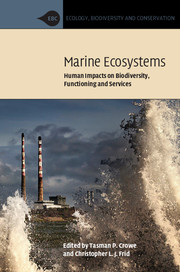12 - Conclusions
from Part III - Synthesis and conclusions
Published online by Cambridge University Press: 05 June 2015
Summary
Introduction
Marine ecosystems provide a range of essential benefits to society, including food and other products, waste assimilation, coastal protection and climate regulation as well as less tangible, but no less important cultural and aesthetic benefits (Chapter 2). To a considerable degree, those benefits are underpinned by ecosystem services dependent on the efficient functioning of the ecosystems, although detailed understanding of relationships between particular services and particular functional processes is currently being developed (Chapter 2). In turn, the efficient functioning of ecosystems has been linked to the number and identity of species present, as well as the prevailing environmental conditions (Chapter 5).
Society derives many of its benefits from ecosystems via sectoral activities and industries, such as fishing, construction, energy, shipping, leisure and tourism. These activities can impose pressures on ecosystems, such as removal of biomass, inputs of nutrients and other contaminants and the introduction of artificial structures and non-indigenous species (Chapter 3). Such pressures act through a range of mechanisms affecting different levels of biological organisation to modify biodiversity and ecosystem functioning (Chapters 3 and 4). The chapters in this book have reviewed current knowledge of how the spectrum of human activities and pressures (collectively referred to as stressors) affect biodiversity, ecosystem functioning and the provision of services and benefits to society. A key objective was to provide a synthesis of evidence for policy makers and managers to facilitate trade-offs between sectors of activity based on the benefits they provide weighed against the degree to which they may compromise the delivery of ecosystem services now and into the future (see Chapter 11).
In this chapter, we first synthesise and summarise the inferences presented in the book about the range of impacts of different activities and pressures on biodiversity and ecosystem processes. We then ask how this kind of knowledge can help policy makers and managers, particularly in the achievement of the international targets laid down in the Millennium Development Goals (Chapter 1) and whether the ecosystem approach and the concept of ecosystem services can provide an effective framework for facilitating the achievement of those goals.
- Type
- Chapter
- Information
- Marine EcosystemsHuman Impacts on Biodiversity, Functioning and Services, pp. 377 - 394Publisher: Cambridge University PressPrint publication year: 2015



